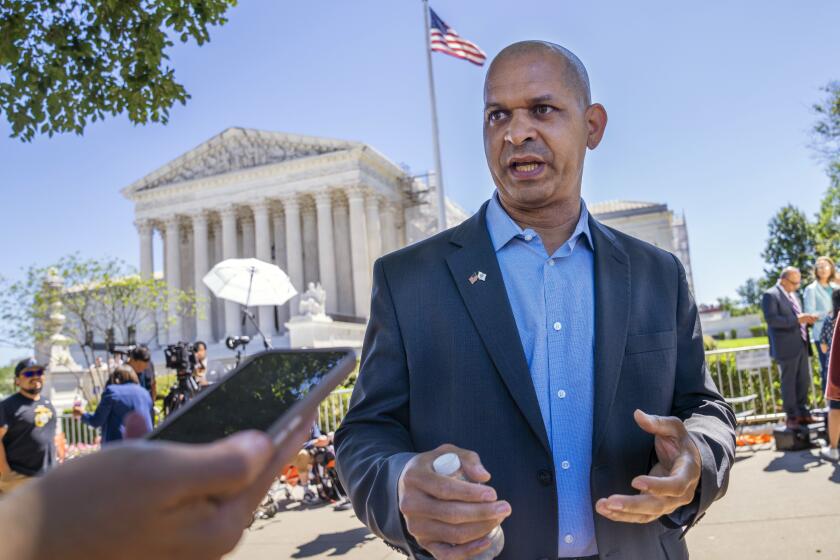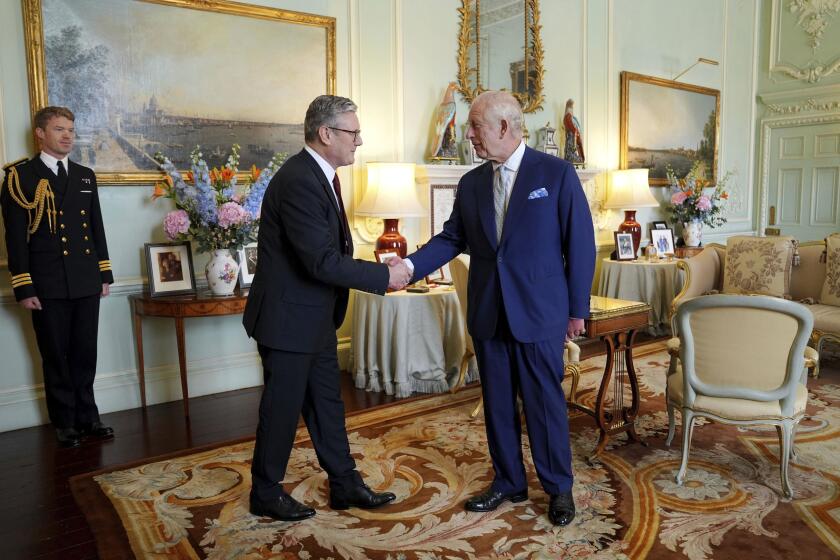Launch of Deep-Space Payloads in Limbo : Demise of $1-Billion Shuttle-Centaur Rocket Puts Missions on Hold
The upside was marvelous--a rocket to propel scientific probes into deep space, to the planets, to the sun itself.
But the downside was horrific.
An Air Force report called NASA’s shuttle-Centaur rocket a “veritable bomb” and the Department of Energy said if it exploded during liftoff, it would destroy the shuttle and its crew. But that is not the half of it: The shuttle-Centaur would be carrying a nuclear generator. If the generator were damaged in a launch-pad catastrophe, it could release cancer-causing radiation into the skies over central Florida--the ultimate nightmare at Disney World.
Weighing the adventure against the risk, NASA had laid plans to launch its first shuttle-Centaur mission this year.
The Challenger explosion a year ago this week first delayed the mission and finally NASA--now weighing the risk against the adventure--cited safety factors and canceled the shuttle-Centaur program altogether.
Money Down the Drain
Almost $1 billion had been spent, most of it now down the drain.
NASA and the Air Force had spent $472.8 million on shuttle-Centaur development. In addition, NASA had paid $411 million for three sets of flight hardware. Cost overruns had reached $250 million and officials estimated another $300 million would have been needed to make the Centaur safe.
Just shutting down the program is costing NASA an additional $75 million, and the entire billion could be lost if the two rockets that have been built can’t be adapted for use on unmanned boosters.
If the loss of money was heartbreaking to NASA accountants, the delay in flights was even more disappointing to the agency’s scientists, for Centaur was not flying just any mission. NASA’s planetary scientists are now left with a major problem: how to launch three long-awaited, prized missions--Galileo to Jupiter, Ulysses to orbit the sun and Magellan to Venus.
On top of that, junking the shuttle-Centaur program has the Defense Department searching for alternative means to boost six military payloads.
Long-Lived Controversy
Shuttle-Centaur has been controversial since the mid-1970s when the space agency began shopping for a “high energy” upper-stage rocket to boost military and civilian satellites out of orbiting shuttles.
NASA and the Pentagon agreed that it should be a solid fuel rocket for convenience and safety. The Air Force said it would fund development of a two-stage booster, the Inertial Upper Stage, or IUS. NASA said it would pay for development of a third stage for hoisting heavier satellites and propelling deep-space probes.
Developing the rocket, especially the third stage, was more difficult than anticipated and by 1980 it became clear that the IUS contractor, Boeing, would not be able to deliver a vehicle powerful enough to carry Galileo aloft during a 1982 launch window.
And with Boeing still having troubles in 1981, NASA canceled the third stage and announced that it instead would use a modified version of its liquid fuel Centaur rocket in the shuttle.
Holds Dangerous Fuel
The Centaur had been used as a reliable upper stage on unmanned Atlas and Titan rockets for more than a decade, lifting satellites, moon probes and planetary explorers. But its use on the shuttle would require carrying liquid propellant with all its pipes and valves--leak opportunities, one and all--in the cargo bay for the first time. The rocket is powered by tricky-to-handle liquid hydrogen, using liquid oxygen as an oxidizer. The hydrogen had to be maintained in the tank at a temperature of minus 423 degrees to remain liquid, the oxygen at minus 297 degrees.
Making Centaur safe to be carried on a manned vehicle would require several modifications, including a dump valve for jettisoning 17,500 gallons of fuel in case the shuttle had to make an emergency landing with the rocket still in the bay. Moreover, the fuel tank would have to be shortened and widened to fit into the cargo bay.
The White House Office of Management and Budget took a dim view of the costs of this modification and killed the shuttle-Centaur project. But Centaur proponents eventually won after prolonged debate in Congress and President Reagan approved $140 million as start-up money in the fiscal 1982 budget. NASA’s Lewis Research Center in Cleveland was assigned to manage the effort and General Dynamics Convair Division was awarded the contract.
Some Express Concerns
Still, some people were unhappy about the safety aspects, particularly officials and astronauts at the Johnson Space Center in Houston, which managed the shuttle program.
“Johnson was especially concerned about what we call the common bulkhead,” explained Joe Mahon, director of space transportation support in NASA’s Office of Space Flight. “In the Delta rocket, for example, there is an oxidizer tank and a fuel tank and each has separate walls. In Centaur, to conserve weight and make it the race horse that it is, there is a common bulkhead between the two tanks. That meant that the system had to be pressurized to keep it safe while it was on board the shuttle.”
Dumping fuel in an emergency would require swift, complex pressurization changes that some engineers feared could stress the thin-skinned tank, causing a leak or an explosion or both.
“We looked at it carefully and said that to get the planetary missions off--and there were only two at that time--the goal was worth the risks,” Mahon said. “And we would work toward a logical reduction of those risks to where they would be acceptable.”
He said the Lewis center and General Dynamics were doing just that when the Air Force decided that it had some payloads that could be boosted out of the shuttle by Centaurs. But it did not need something quite as powerful as the planetary Centaur; NASA developed a shorter version, 19 feet long, compared to 29 feet.
Problems Cause Delays
“There was an 80% commonality in the two,” Mahon said. “But there were different designs and we slowed some work on the planetary programs to meet the Defense Department requirements.”
There also were other technical problems, such as a failed valve that had to be redesigned, which added to cost overruns and delay.
As a result, he said, officials began to worry that they would lose the May, 1986, target dates for launching Galileo and Ulysses. Opportunities to launch both are available for only a few days once every 13 months because of Jupiter’s shifting position in relation to the Earth. Galileo is to orbit Jupiter, while Ulysses is to pass close to that planet to use its gravity field like a slingshot to fling it outward toward the sun.
“We were beginning to see indications that it was close,” Mahon said. “It depended upon how much we wanted to waive on it. For example, the oxygen vent valve on the Centaur was made of a Teflon coating. The Johnson Space Center ruled that Teflon and oxygen are like gasoline and alcohol. They don’t mix, so you should not use them. But for these two flights, we had a waiver for doing that, but subsequent Centaurs downstream would not.”
No Longer a Rush
Then Challenger exploded 73 seconds after liftoff on Jan. 28, 1986, killing the seven crew members, and, with the shuttle fleet grounded, there no longer was any rush to meet the May launch dates.
The Rogers commission, which investigated the accident, said the accident was caused by hot gases leaking through a ruptured joint in one of the shuttle’s two solid fuel rocket boosters. The tragedy touched off an investigation of safety aspects of all shuttle systems, including Centaur.
Preliminary testing of the first two shuttle-Centaur stages was under way at the Kennedy Space Center in Florida when Challenger exploded. But center safety director Marvin L. Jones wrote shuttle managers on Feb. 10 that he could not approve advanced testing because he lacked safety verification data from Lewis center and General Dynamics.
Memos written before the tragedy began to surface.
One, from then-shuttle director Jesse Moore, said: “There is a cause for concern, and the ‘fly as is’ decisions on the flight hardware for our first two missions must be monitored very closely. The shuttle-Centaur team should be made aware and sensitive to the potential for increased safety risk due to the individual acceptance risk of these ‘fly as is’ hardware decisions as well as overall increased risks in general.”
Cites ‘Old Philosophy’
Another, from NASA’s Aerospace Safety Advisory Panel, said: “The problem of mating the Centaur with the manned shuttle was underestimated by everyone. The system should realize that the old philosophy that technical perfection is more important than schedule has changed with Galileo and Ulysses.”
Rep. Edward J. Markey (D-Mass.), in a letter to Energy Secretary John S. Herrington, said the panel’s memo “would appear to indicate that safety concerns had, or potentially would have, become subordinate to meeting schedule requirements.”
Markey joined other critics who were concerned about the nuclear power generators that would be used to power Galileo and Ulysses. These radioisotope thermoelectric generators each would carry 48 pounds of plutonium.
The Massachusetts congressman in March released previously classified Energy Department documents that said an explosion of the shuttle on the launching pad during either of the Centaur planetary missions could, under certain circumstances, release enough radioactive material to contaminate 386 square miles and cause 43 cancer deaths over a 50-year period.
Threat to Magic Kingdom?
The fallout area includes Disney World, the popular tourist attraction 50 miles west of Cape Canaveral, and the threat raised the specter of radiation showering down on the Magic Kingdom and tens of thousands of people in the park.
“Disney World certainly does not need a Plutoniumland,” Markey said at the time. Disney World itself had no comment on the possibility.
The report said that would be a worst-case scenario and it rated the chances of a plutonium-caused cancer death as “20 times less likely than being killed by lightning.”
NASA noted that nuclear generators had been carried for years aboard most of its planetary missions and on some satellites and had never caused a problem. One was recovered intact from the floor of the Pacific Ocean after it survived the explosion of a satellite rocket launched from Vandenberg Air Force Base.
The generators are needed for deep-space probes because they fly so far away from the sun that solar cells normally used on satellites to gather solar power are not practical.
‘Veritable Bomb’
Markey said NASA’s own internal documents called for a thorough investigation of the rocket’s safety.
He referred to a 1983 Air Force report that said, “After an abort, the Centaur is a veritable bomb if not drained of its fuel.” The report urged development of a fail-safe system to jettison the fuel.
Mahon said engineers had confidence in the dump system that was designed.
On March 27, the space agency’s chief engineer, Milton A. Silvera, wrote a six-page memo expressing concern that neither the Lewis center nor General Dynamics had ever had any experience with manned space missions and therefore had not properly addressed safety issues. He said they were treating Centaur more as a payload than as an integral part of the shuttle.
Silvera also said he was worried about the large number of waivers approved on Centaur flight issues and about the adequacy of Centaur ground tests. He recommended independent safety analyses and reviews be established to oversee General Dynamics and Lewis on safety issues.
Leaders Apply Pressure
In early June, congressional leaders applied pressure on NASA to halt the shuttle-Centaur program after an investigation was conducted by the staff of the House Appropriations subcommittee.
On June 19, the agency’s administrator, James C. Fletcher, announced cancellation of the project, citing safety concerns. “Although the shuttle-Centaur decision was very difficult to make, it is the proper thing to do, and this is the time to do it,” he said.
Would the two planetary flights have flown in May with the Centaurs aboard if Challenger had not exploded? Officials said probably not, because the Centaurs probably would not have been ready.
But Mahon said he believes Centaur eventually could have been made a safe vehicle.
“There’s a whole engineering community that says with enough time and dollars you can make it safe to fly,” he said. “But you have to understand we’re in the emotional aftermath of Challenger.”
Can anything be salvaged?
sh Parts May Be Useable
Mahon said NASA has offered to transfer the completed flight hardware to the Air Force for use as upper stages on the new Titan 4 rocket it is developing. The rockets would require significant modification to fit atop Titan 4s, but Mahon said such things as the engines, guidance systems, computers and inertial reference packages are usable.
What about Galileo, Ulysses and Magellan, the sorts of missions that scientists and youngsters like to dream about?
“Of course we’re disappointed with the delays,” said Frank Bristow of NASA’s Jet Propulsion Laboratory in Pasadena. He said Galileo scientists are particularly upset because that probe originally was to have been launched in 1982.
“They’re all exciting missions,” Bristow said. “Ulysses, which is a European-built spacecraft, will give us our first look at the polar regions of the sun, and its study of the sun’s radiation, magnetic field, sunspots and the solar wind could provide important clues to the relationship between sun and Earth. The Magellan mission will map the entire surface of the planet Venus for the first time and tell us much about that mysterious planet.”
Not Just a Mission
“Galileo is viewed as far more than just another Jupiter mission; it is to be an exploration of an entire planetary system,” said Terence V. Johnson, Galileo project scientist at the Jet Propulsion Laboratory. “For the first time man will be able to study in detail the phenomena of the planet Jupiter itself and also of its orbiting moons.”
Galileo is to orbit Jupiter and drop the first probe into the Jovian atmosphere.
Discussions have been held with the Air Force about using a Titan 4-Centaur rocket for the three missions, but Mahon said that it is more likely all three will be launched from shuttles using upgraded Inertial Upper Stages.
A recently released shuttle manifest lists all three payloads for launches in 1989 and 1990.
If that decision holds, Markey or some other congressman or group is likely to once again question the use of nuclear generators.
More to Read
Start your day right
Sign up for Essential California for news, features and recommendations from the L.A. Times and beyond in your inbox six days a week.
You may occasionally receive promotional content from the Los Angeles Times.






